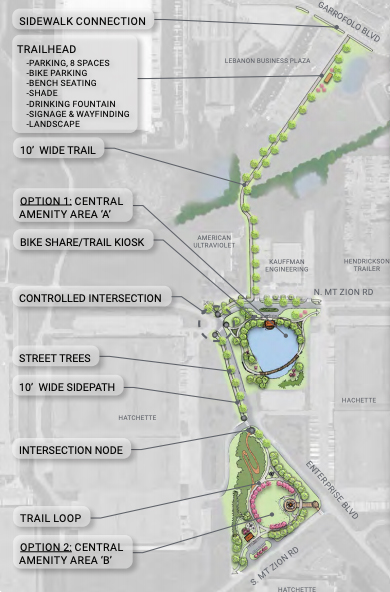Latest Blogs
-
Kim and Todd Saxton: Go for the gold! But maybe not every time.
-
Q&A: What you need to know about the CDC’s new mask guidance
-
Carmel distiller turns hand sanitizer pivot into a community fundraising platform
-
Local senior-living complex more than doubles assisted-living units in $5M expansion
-
The number of new COVID cases continues to drop in Indiana
As the Lebanon Business Park nears capacity, the city is considering a plan to line right-of-ways with trails and recast an adjacent space as a pocket park, for a cost as much as $13.7 million.
Lebanon’s city council will consider formally adopting the green-space plan during its Feb. 8 meeting.
In May, the city of Lebanon hired North Carolina-based engineering consultant Kimley-Horn to create a mobility plan that would attract businesses and recreational users to the 26-year-old Lebanon Business Park. Kimley-Horn delivered a draft plan in December with conceptual designs for roughly 10.5 miles of trails and green infill projects using what Lebanon Planning Director Ben Bontrager calls “opportunistic funding” through state grants.
“We’ve always talked about the fact that there’s not connectivity—other than car connectivity—in our business park,” Bontrager said. “When you look at economic development and things that are desirable to businesses owners, getting people to work by methods other than their cars or for them to have something to do during their half-hour lunch break is a real amenity.”

The 1,250-acre Lebanon Business Park is bounded by State Road 32 to the north, State Road 39 to the southwest and I-65 to the east.
As of December, the park’s 25 buildings were occupied by 26 tenants specializing in varied industries, from outdoor gear to food manufacturing to medical supplies to power tools. Bontrager said Wednesday that there are roughly 30 acres left within that park that could be developed for industrial uses.
“You look back over time and the utilitarian concept behind a business park is, you need to create the roads to get the trucks in and out,” Bontrager said. “You do just what’s necessary to bring in businesses and make money. Now, the quality of life and amenities of a community are rising on that list of criteria and decision making for those businesses.”
Kimley-Horn’s plans identify Enterprise Boulevard, which connects State Road 32 to the north and State Road 39 to the south, as the primary spine for nine interconnected trail segments.
- State Road 32
- Features: 8,592 linear feet of trail, 86 trees, pedestrian bridge
- Estimated cost: $3 million to $3.5 million
- State Road 39
- Features: 4,388 linear feet of trail, 44 trees, signalized crossing
- Estimated cost: $800,000 to $1 million
- Enterprise Boulevard
- Features: 11,288 linear feet of trail, 113 trees, pedestrian bridge
- Estimated cost: $1.8 million to $2.2 million
- Hospitality Connection
- Features: 1,928 linear feet of trail, trailhead amenities
- Estimated cost: $350,000 to $400,000
- Zion Road East
- Features: 3,026 linear feet of trail, crossing
- Estimated cost: $450,000 to $600,000
- Zion Road West
- Features: 4,463 linear feet of trail
- Estimated cost: $650,000 to $800,000
- Edwards Drive
- Features: 3,327 linear feet of trail, crossing
- Estimated cost: $500,000 to $650,000
- Abner-Longley Connection
- Features: 5,388 linear feet of trail
- Estimated cost: $800,000 to $1 million
- Future Connections
- Features: 10,507 linear feet of trail, trailhead, railroad crossing
- Estimated cost: $1.6 million to $2 million
Kimley-Horn also made conceptual designs for two potential amenity areas where Enterprise Boulevard meets North and South Mt. Zion Roads. The city likely would choose one of the two options, Bontrager said.
One of the designs would outfit a detention pond owned by the park’s developer, Indianapolis-based Duke Realty, with an open-air pavilion, a fishing deck, a bike share kiosk, a boardwalk, interior trails and landscaping for between $750,000 and $900,000.
Alternatively, the city could try to acquire another undeveloped parcel nearby to build a playground or splash pad, public restrooms, a reforestation area with interior mulch pathways and more for $1.4 million to $1.6 million.
Kimley-Horn mentions the potential use of tax increment finance funds for the project, but Bontrager said it was unlikely the city would decide to issue bonds. Instead, the plan is to court state and federal funding through grant programs, and thus it could be decades before the plan is fully implemented, Bontrager said.
“That’s probably the biggest unknown at this point,” he said. “This is a long-term project, but having a plan in place gets us started somewhere. This is really just to set the groundwork for how we might attack this, then we’ll take off bite-size pieces. We certainly would like to address some of this in the next five to 10 years.”
Please enable JavaScript to view this content.


You build one of the most successful business parks in the nation, pass out property tax breaks to nearly anyone who requests them and now you want to to request state and federal funds to build the trails you should have planned for and building since the first building was built. What’s wrong with this picture?